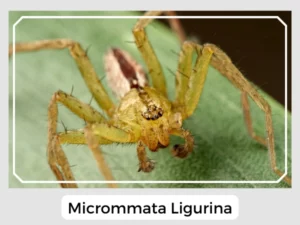The Micrommata spiders are part of the huntsman spider family. With about six species known, these spiders are fascinating to learn about. Here, we will share some cool facts about these amazing creatures for you to read.

The eggs remain safely enclosed in a clutch and hatches in four to five weeks.
Their color patterns also vary, like the juveniles of the Green Huntsman kind have a yellowish-brown cephalothorax.
The species of this genus do not build webs like all other huntsman spiders but hunt for their prey.
Yes, Micrommata spiders have venom, like most spiders. But their venom is not considered harmful to humans.
Micrommata spiders can bite if threatened, but bites are rare. If bitten, most people might feel mild irritation or slight pain.
Micrommata spiders play a crucial role in maintaining ecological balance. By preying on small insects such as flies, worms, and wasps, as well as geckoes and birds, they help control the population of these species. Their hunting nature contributes significantly to the food web, impacting various trophic levels.
Natural Predators: Just like they prey on other creatures, Micrommata spiders also face threats from predators. Birds and larger insects can pose a danger to these spiders, serving as a natural check on their population.
Prey-Predator Dynamics: The dynamics between Micrommata spiders and their prey is a fascinating aspect of their ecology. Their ability to hunt and capture a variety of prey showcases their adaptability and importance in maintaining a balanced ecosystem.
Relationship with Humans: Though their venom is not harmful to humans, it is crucial for people to understand the role of Micrommata spiders in the environment. Education and awareness can foster a harmonious coexistence, appreciating these spiders for their ecological contributions.
| Lifespan | Approximately two years |
| Distribution | It has a Palaearctic distribution, stretching across Europe, Asia, and parts of North Africa |
| Habitat | Small insects |
| Diet | Flies, worms, wasps, geckoes and birds |
In wrapping up, Micrommata spiders are a fascinating group with a diverse range of species, each contributing to the ecological balance in their own unique way.
The Micrommata spiders are part of the huntsman spider family. With about six species known, these spiders are fascinating to learn about. Here, we will share some cool facts about these amazing creatures for you to read.

The eggs remain safely enclosed in a clutch and hatches in four to five weeks.
Their color patterns also vary, like the juveniles of the Green Huntsman kind have a yellowish-brown cephalothorax.
The species of this genus do not build webs like all other huntsman spiders but hunt for their prey.
Yes, Micrommata spiders have venom, like most spiders. But their venom is not considered harmful to humans.
Micrommata spiders can bite if threatened, but bites are rare. If bitten, most people might feel mild irritation or slight pain.
Micrommata spiders play a crucial role in maintaining ecological balance. By preying on small insects such as flies, worms, and wasps, as well as geckoes and birds, they help control the population of these species. Their hunting nature contributes significantly to the food web, impacting various trophic levels.
Natural Predators: Just like they prey on other creatures, Micrommata spiders also face threats from predators. Birds and larger insects can pose a danger to these spiders, serving as a natural check on their population.
Prey-Predator Dynamics: The dynamics between Micrommata spiders and their prey is a fascinating aspect of their ecology. Their ability to hunt and capture a variety of prey showcases their adaptability and importance in maintaining a balanced ecosystem.
Relationship with Humans: Though their venom is not harmful to humans, it is crucial for people to understand the role of Micrommata spiders in the environment. Education and awareness can foster a harmonious coexistence, appreciating these spiders for their ecological contributions.
| Lifespan | Approximately two years |
| Distribution | It has a Palaearctic distribution, stretching across Europe, Asia, and parts of North Africa |
| Habitat | Small insects |
| Diet | Flies, worms, wasps, geckoes and birds |
In wrapping up, Micrommata spiders are a fascinating group with a diverse range of species, each contributing to the ecological balance in their own unique way.